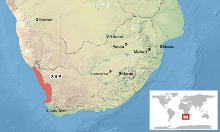Namaqua rain frog
| Namaqua rain frog | |
|---|---|
| Scientific classification | |
| Kingdom: | Animalia |
| Phylum: | Chordata |
| Class: | Amphibia |
| Order: | Anura |
| Family: | Brevicipitidae |
| Genus: | Breviceps |
| Species: | B. namaquensis |
| Binomial name | |
| Breviceps namaquensis Power, 1926 | |
 | |
The Namaqua rain frog (Breviceps namaquensis) is a species of frog in the Brevicipitidae family, found in South Africa, Zimbabwe, and possibly Namibia. Its natural habitats are subtropical or tropical dry shrubland and sandy shores. It is threatened by habitat loss.
Identification
Adult frogs attain a body length of 46 mm (1.8 inches).
The Namaqua rain frog has a squat, round body with a short, narrow head which has relatively large eyes, a flat face and narrow mouth. The limbs are short and stumpy and the fingers and toes lack webbing and adhesive discs. The upper body surface is brown with lighter brown to cream patches on the back and sides. These patches are occasionally fused together and may include irregular pairs of paravertebral patches. The underside is mainly smooth and white, but the skin is translucent in parts, and the throat area may be granular with dark markings around the jaw line.
Behaviour
This frog is a burrowing species that spends most of its time underground and does not inhabit water. It occurs generally in dry, low-lying areas that are predominantly sandy and well covered with scrub vegetation - but has also been recorded in hilly areas with more loamy and rocky substrates. When disturbed, these frogs have the ability to inflate their bodies dramatically and squeak as a defence mechanism to deter predators, which has gone viral in this video. Breeding activity has been recorded in winter, spring and summer. They spend most of their time underground, surfacing after the rains to feed on insects. Its eggs are laid in underground chambers and are covered in a thick, viscous, jelly-like substance. Once the eggs hit tadpole stage, the jelly softens into a fluid in which they live until they fully metamorphose into frogs (absorbing nutrients from the egg yolk as they grow).
References
- Minter, L., Channing, A. & Harrison, J. 2004. Breviceps namaquensis. 2006 IUCN Red List of Threatened Species. Downloaded on 23 July 2007.
| ||||||
